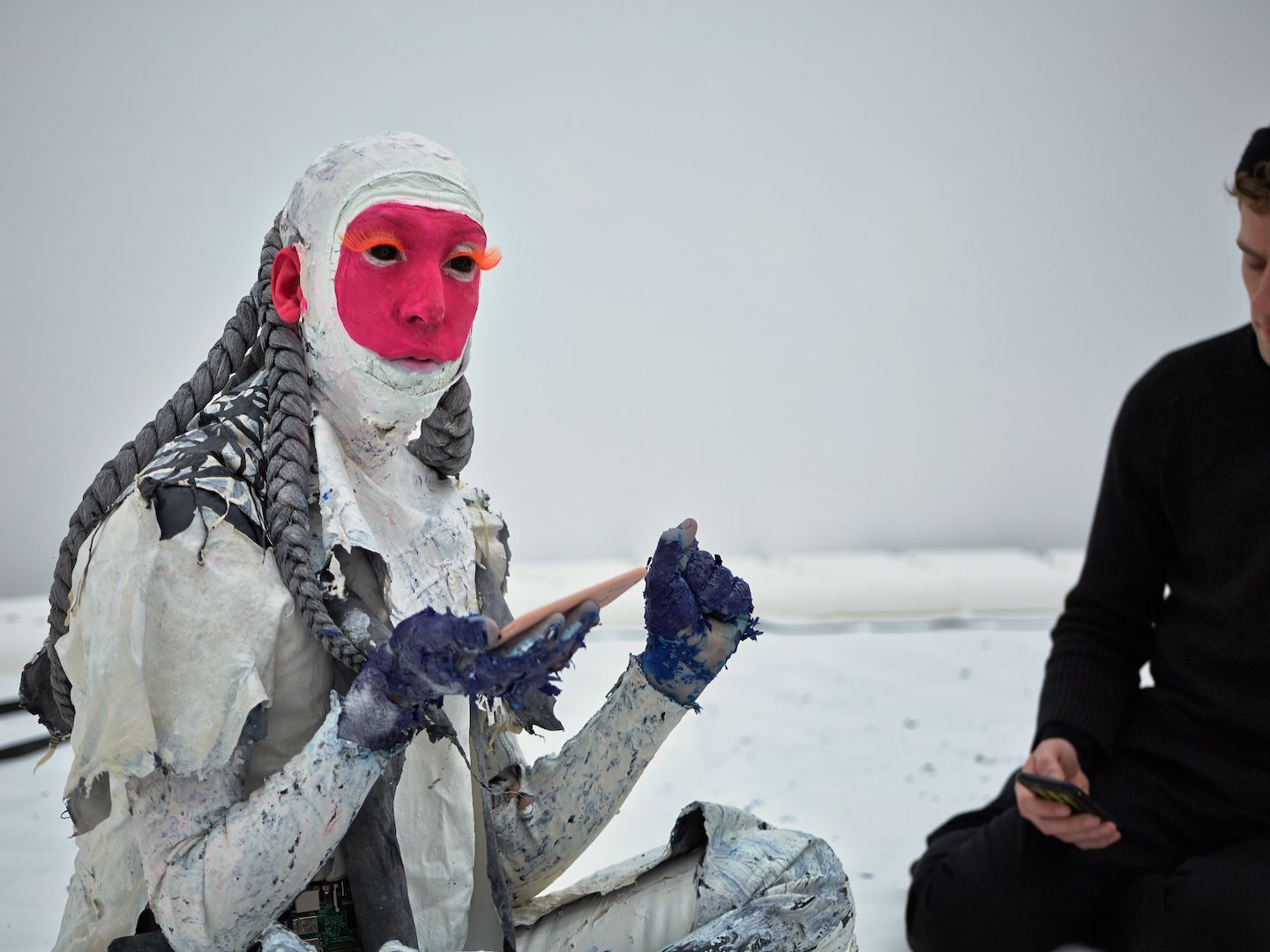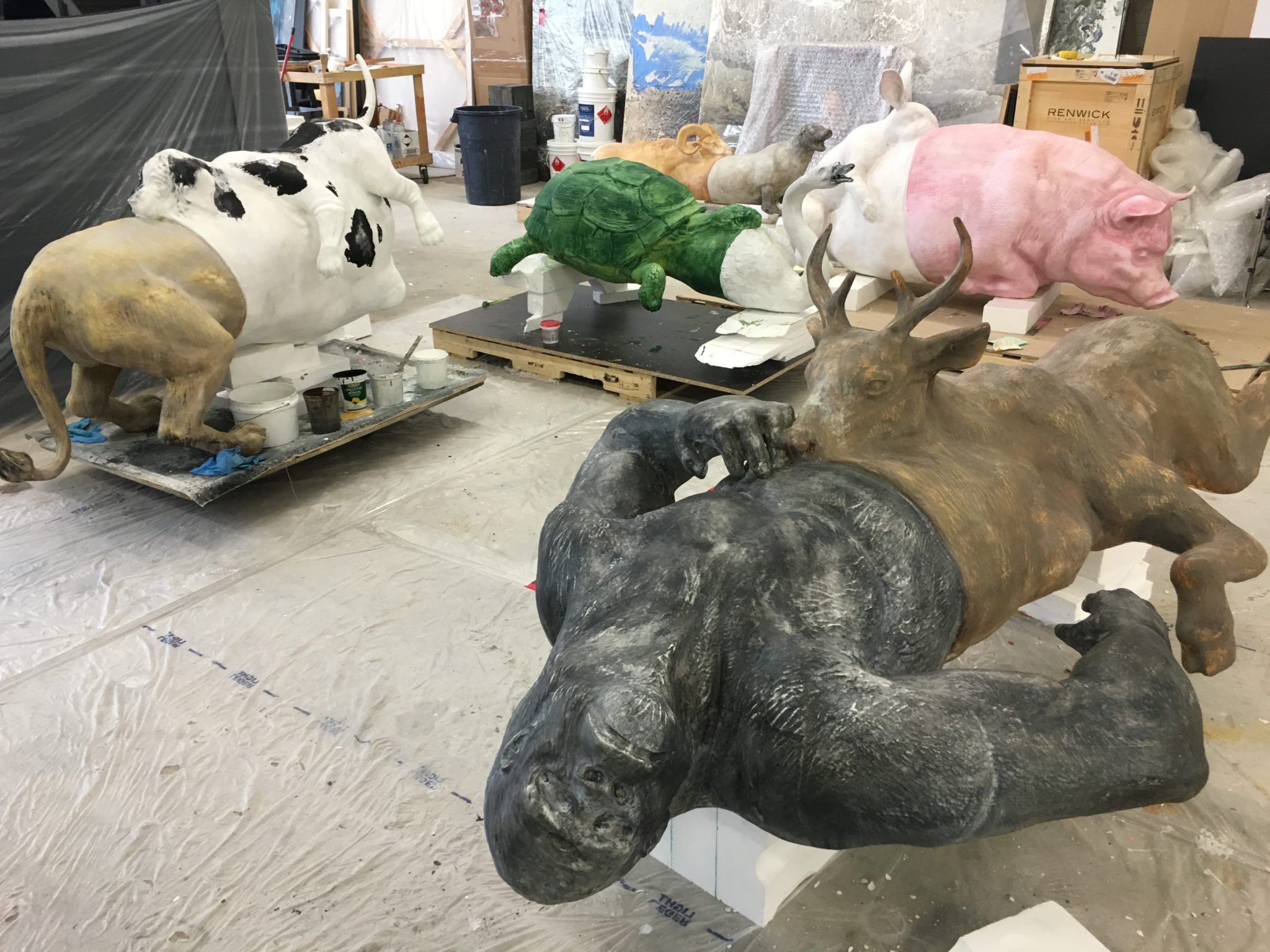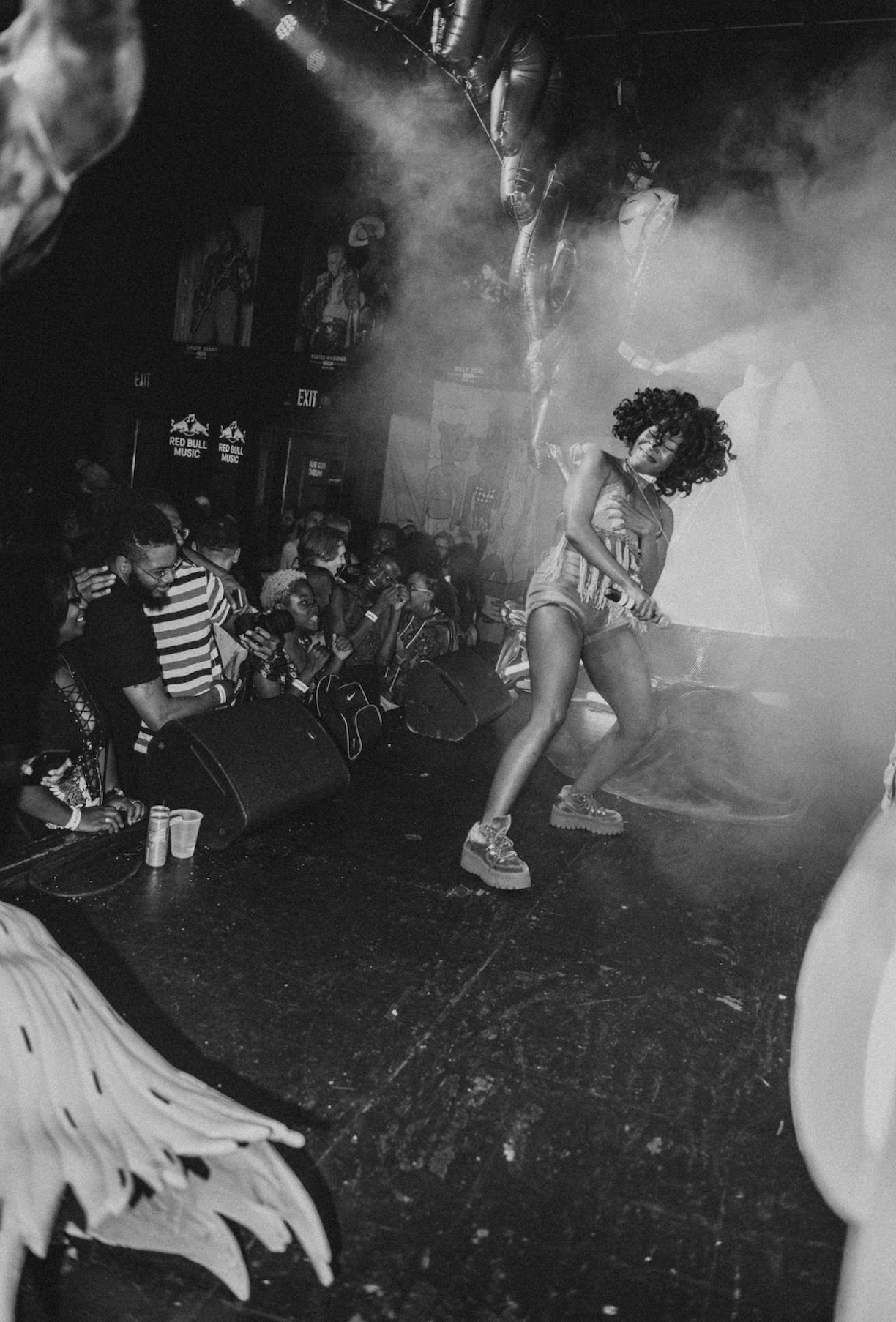JOHANNES PAUL RAETHER is Queen of the WORLDWIDEWITCH Community
|Oliver Körner von Gustorf

Ikea. Utero Capitalism. Apple. Techno-Alchemy. Johannes Paul Raether’s subject matter is as urgent as his performances are baffling. The androgynous beings he has created seem to originate in outer space – an enlightened alien species here to save Planet Earth from the conformist web of traps we have spun for ourselves. The artist – who will take part in Persisting Realities as part of Berlin’s CTM Festival from January 25 until February 2, 2019 – enacts his work through three main characters, or witches: Transformalor, Protektorama, and Schwarmwesen. These three archetypes split off into detailed personalities, each with different traits and varying agendas, and act under the umbrella term of the World Wide Witch Community.
To understand the wishes of this anarchic alien-creature, one must truly connect with Transformalor’s constantly mutating data-body. Will the cyborg witch break character, at least for our author?

“I am many, and I am we,” says Transformalor in a teacher’s tone, as though we should memorize it. We are then told to take off our shoes and form a circle.
The androgynous, alien-like creature calls our small group “The Coming ReproTechnoTribe”: the Spanish lady with her sister and child, the hipster-curator guy, the other two young women, and me. Wearing only our socks, we feel the softly-knobbed texture of the “Zewa Arena,” a force field consisting of hundreds of unfurled paper towel rolls laid out in a circle. The antiseptic-seeming installation is certain to be covered with lint, liquids, and footprints later on. After all, Transformalor – i.e. performance artist Johannes Paul Raether’s “propaganda avatar” – will be making the rounds all day with a new group each time. It is a continuous performance during which he speaks about complex things such as in vitro fertilization – the freezing of genes, ova, and sperm –surrogate mothers, the global industrial market of human reproduction, “ReproReality,” and the coming “Reprovolution.”
It is a gray Saturday morning in Berlin’s Kreuzberg district. Transformalor blocks their cave/cage/office at the gallery Kraupa-Tuskany Zeidler, where they give performance lectures, incubate ideas and identities and regenerate themself. They push the Wächterinnen [“Female Guards”] (constructions made from the frames and wheels of baby buggies) in front of the passage to the showroom – futuristic, techno-praying-mantises standing watch over the minimalist arena. Transformalor, or more precisely, [Transformella malor ikeae] version number [4.4.6.6] flutters their glowing, orange eyelashes. Their skin is the color of dust, chalk, dirty frozen milk. This plural being must have shed its skin again and again on the infinitely long journey, developing into new versions. They have recycled the discarded casings of their forerunners and sutured them into a cap, cape, legwarmers. The serpentine, plaited braids recall science fiction creatures such as the Predator or the ethno-avatars from James Cameron’s blockbuster. At the same time, the creature has an almost spiritual charisma. The magenta face has the look of a painted Butoh mask, or an archaic deity’s visage. Take it off, and you would probably find nothing, just white.
“Bodies of the future will have to be assembled from the remnants and shreds of affluent capitalist society.”
Transformalor squats in the middle of the paper-towel circle and unfolds a black map upon which Johannes Paul Raether has recorded his Identitektur [“Identitecture”]. The diagram resembles something used in natural history or history lessons, and shows the evolution of his various performance identities since 2010. Besides Transformellae, the genus devoted to modern biology and reproduction technologies, the diagram also includes Schwarmwesen [Swarm-Being] and the Protektoramae, a line of WorldWideWitches. These techno-alchemical witches do rituals to heal people’s smartphone fetish obsession and closely study the geopolitical consequences of the information- and computer technologies boom.
To better illustrate this, Transformalor asks the group to connect to their home-built server – which Raether has strapped around his stomach – via their smartphones. “I built my data body so the lifelines of my figurations don’t get lost,” he explains. “It doubles its own, biological body in the form of stories, images, news, and ideas that are stored on it.” We log in, connect our data bodies to Transformalor’s. There’s something uncannily physical, intimate about this mini-network for a moment. If we can peer into the life of this alien, can it also see our own data and images, our story? Diagrams, pamphlets, and pictures appear on our “screen bodies,” as Transformalor calls the smartphones. We see the blue-skinned witch Protektorama, rehearsing ritual dances with township dwellers at a recycling center in Johannesburg, or establishing a smartphone healing circle at an archaic cult site in Scotland. We see Transformalor’s predecessor Transformella bathing in the Ganges alongside devout Hindus, wearing a latex suit and rubber gloves. She’s on her way to an interview with Nayna Patel, an Indian entrepreneur who has produced and sold over a thousand “surrogate babies” at her Akanksha Infertility Clinic. Transformalor calls Patel the first “uterocapitalist” in a rapidly-growing transnational market.
Then we see images of what are arguably Raether’s most controversial interventions – or “infiltrations” – that have earned him huge media coverage. Performances for which he, dressed as an alien or a blue witch, appears completely unannounced to lead groups of participants through Ikea and Apple flagship stores. Raether’s travesties are even more surreal in these shopping environments: beholding him as a latex psycho-mom among custom kitchens, surrounded by art fans and customers, engaged in a discussion with Ikea employees.
The image of him jumping between parked cars as a Transformalor alien looks like a horror movie. In 2016, he dressed up as a blue witch and marched into the Apple Store in Berlin with twenty people. His goal: to hold a “techno-alchemical” ritual there that would merge the rare earth metals found in any computer and smartphone with gallium. Gallium is a metal that is harmless to humans and melts at body temperature, but it decomposes the aluminum from which almost all computers and smartphones are made. The fusion of “warm, soft gallium” and the “hard” earths that have been exploited under inhuman conditions is a symbolic act. But then, when the gallium trickles out of the participants’ hands, panic breaks out.


The store’s management suspect a terrorist attack when it sees the blue – this time bald-headed – witch wearing a jersey and leather harness, as though she had just come back from winning a bicycle race in hell. Management calls the police. A commando team rolls up and evacuates the store and all its 500 customers. The performance group is circled with barrier tape and submitted to criminal identification in front of the store. The next day, a picture of the arrested Protektorama witch appeared in every Berlin newspaper. “What an idiot,” German tabloid B.Z. printed on its front page, portraying Raether as a dangerous freak and anarcho-clown from the autonomous scene.
The 40-year-old is a professor at the Kunstakademie Düsseldorf, and in recent years has presented his work at the Stedelijk Museum in Amsterdam, the 9th Berlin Biennale, Palais de Tokyo in Paris, and the Fridericianum in Kassel. Raether is considered one of the most important performance artists in contemporary art, and his role is becoming increasingly important in the current discourse. How does that square with the picture of an anarchist alien being?
“I call my figurations ‘vessels’ or ‘skins.’ They are nothing more than a vehicle for me,” Raether says a few days later in a conversation about his performance. He speaks about how he learned the craft of individual transformation from legendary activist and drag queen Mother Flawless Sabrina and her boyfriend Curtis Carman in New York in the early 2000s. But he himself does not see his interventions as drag: “These days, I think make-up is more a technology of social transformation.”
Raether, now dressed in a bomber jacket and wool hat, looks a bit groggy. After a talk in Frankfurt with Museum für Moderne Kunst director Susanne Pfeffer and showing his most recent performance series in Berlin, he spent several days sick and exhausted in bed. The visual contrast between his performance appearances and his “normal” alter ego is enormous, but there is something constructed, artificial, and condensed about his speech in everyday life as well: “Hacking or chopping up bodies, breaking them down into their individual parts, and putting them together in a bricolage or assemblage is very, very, important to me. That’s what I’m suggesting, also as a counter-project to highly-cultivated techno bodies.”
Raether is a round-the-clock discourse witch. He does not go home to his “authentic” self. He is an absolute transformer. Someone equally fluent in the language of the club scene, the visual vocabulary of past subcultures, and contemporary pop culture, but also that of curators and theorists. His self-presentation – an amalgamation of fetish gear and precarious pieces fished from the garbage, fused into an inhuman, technoid look– would be the envy of any Hollywood stylist. When asked if it doesn’t bother him that mainstream stars like Lady Gaga or Janelle Monáe have long since appropriated and marketed the same queer cyborg aesthetic that he references, he replies: “I like that a bit of Lady Gaga is being stuffed into this shell and taken into the future. Bodies of the future will have to be assembled from the remnants and shreds of the affluent capitalist society.”


Raether studied and began his career in Berlin in the late 1990s and early 2000. He was part of the Berghain club scene, was active in an Antifa-type environment, and worked at one of the city’s most powerful galleries. The mid-noughties found him engaged in discourses that are only now reaching mass culture ten years later: the idea of transsexuality, fluid identity, a remake of left-wing feminism that also includes questions of class, race, and conditions of production. Raether reads queer theory – another politicizing factor in the Berlin art scene at that time – like the “Contra-sexual Manifesto” by Spanish transgender activist Beatriz Preciado, for example, which vehemently opposes the notion of binary genders. Another essay impacted Raether even more: Donna Haraway’s “Cyborg Manifesto” from 1985. In it, the American feminist examines possible interfaces between man and machine and views new technologies and the creation of artificial life forms as a liberating chance to do away with race, gender, and class altogether.
Raether made a symbolic attempt at this in 2011, during a performance in the project space Basso. Working with a hacker, he built a printer out of threaded rods, circuit boards, and wires that virtually prints itself. The two actually managed to have the machine print sixty percent of its own parts. “Back then, it was the manifestation of a utopian moment, a kind of creation moment,” Raether says, “a genesis of the machine by the machine.” Today, barely a decade later, technology has progressed much further. Anyone with a so-called “MakerBot” can reprint plastic spare parts at home. And yet, “the idea of the self-reproducing machine has once again receded into the distance,” says Raether. The same is true of the utopias dreamed by feminists, who, in the 1970s, had hoped that new possibilities for artificial reproduction would render both the patriarchy and the need to give birth obsolete.
In vitro fertilization, surrogates, and frozen egg cells are not currently used to develop new, divergent family structures or multiple-parent models, but almost exclusively to have a biological child of one’s “own” as a couple. Transformella’s journey to the Indian baby factories follows the genuine flow of fertility tourism undertaken by Western couples. From helicopter mothers to the left-wing scene, the nuclear family seems to have the same dearth of alternatives as capitalism.
Yet at the same time, art and philosophy are thinking ahead to a radically different future – one in which humankind has to give up its supremacy. The 2007 exhibition documenta 12 also indicated that we are no longer the center of the world, that the thought process of bees, rock formations, or strawberries could be equal to ours, that nature has a different kind of consciousness that exists without us. This has the current discourse speaking of “posthuman thought” – the design of a new world full of “inhuman” life forms where humanity, as we know it today, has disappeared.
“Before that, we are customers, isolated individuals, families, friends. But then Ikea realizes that it is a different formation, that we are not doing any shopping here.”
This is exactly what Raether’s “inhuman” identities are all about. Paradoxically, they could only be formed from a fusion of left-wing thought, club culture, and a precise knowledge of the commercial art scene. Raether is fascinated by the latter, even though he looks like an outsider or a fighting machine within the bubble. He is as alien to normal museumgoers as he is to Ikea customers. This is not only because of his make-up, but also on account of his unpredictable tenacity. He goes where families gather – to Ikea – and tests, on site, whether other family life forms are conceivable and feasible. “Both society and the market, as well as the actual bodies, are thought to be incredibly efficient, closed, smooth, and hard,” says Raether. “These are, in principle, characteristics of machines. But as a community, there are ways to oppose this with our self-made and self-determined social body, in order to meet our human needs.”
Transformalor has passed through the furniture store several times since 2015, like the one in Berlin’s Tempelhof district, for example, or in Warsaw. It is the ideal goal for Raether’s figuration, which deals with the reproduction of people and goods. Ikea is the matrix for life in a standardized nuclear family. The global company manages to homogenize the heterogeneous. Millions of people view the images in its sales catalogs, its country-home surfaces, its modular, affordable furniture as the template for an organizable, affordable, happy family life. Everything is okay about the Ikea shopping experience, so long as you are there alone or in a family-like structure. “The walk through Ikea usually goes well, until I, as an avatar, identify those on the tour as members of a group,” says Raether. “Before that, we are customers, isolated individuals, families, friends. But then Ikea realizes that it is a different formation, that we are not doing any shopping here.” At this point Raether and his groups are escorted out of the store.
So, what if the heterogeneous “family” of the future were to be a guerrilla family — ever-changing, opaque, chaotic, and imperfect? What if people could duplicate their identities like the printer that prints itself: not just symbolically, but also materially? What if there were children with three or more genetic parents, new skin colors, genders, cyborg combinations – all of which can be produced in a do-it-yourself process? A good intent to have, Johannes Paul Raether says, is “to realize the imaginable in the possible.” One need only connect to Transformalor’s ever-growing data body to know that this is no queer-political drag show, no theoretical finger exercise. The imaginable is already mutating into possibility. The Reprovolution has long since begun.

Credits
- Text: Oliver Körner von Gustorf

